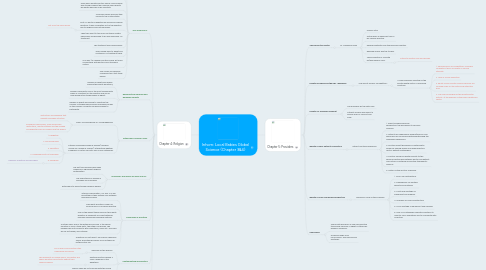
1. Chapter 4: Religion
1.1. The "Americans"
1.1.1. Dalia and Galal are married first cousins.
1.1.2. Dalia married Galal knowing and accepting his fertility problems.
1.1.3. Galal was a wealthy factory owner. Dalia's family was strongly against her marring Galal despite his wealth because of his infertility.
1.1.4. To escape family pressure they moved to the United states.
1.1.5. First IVF doctor suggested an anonymous sperm donation. It was completely out of the question due to religious and culture beliefs.
1.1.5.1. Not from the same blood.
1.1.6. They then went to two more culturally related physicians and decided to do and expensive IVF treatment.
1.1.7. The treatment was unsuccessful.
1.1.8. They moved back to Egypt and continued IVF treatment there.
1.1.9. ICSI was 1/3 cheaper and the couple felt more comfortable with doctors from the same culture.
1.1.10. The couple successfully conceived two "test-tube" babies.
1.2. Reproductive Medicine and Religious Morality
1.2.1. Leaders in Egypt have legally banned third party donations,
1.2.2. Religion represents one of the most fundamental areas of constraint on the practice and use of new reproductive technologies in Egypt.
1.2.3. Religion in Egypt has served to constrain the number of technological advances allowed as well as the number of infertile couples allowed to participate.
1.3. Fatwas and "Official" Islam
1.3.1. Islam: "Encompassing" or "Comprehensive"
1.3.1.1. Instruction and guidance that regulate everyday activities.
1.3.1.2. Examples: Daily prayer, food and alcohol restrictions, marital relations and the allowed and expected care of orphans and the elderly.
1.3.2. Fatwas: nonbinding religious opinion (decided usually by a religious scholar) interpreting whether a behavior or action falls into one of five categories.
1.3.2.1. 1. Obligatory
1.3.2.2. 2. Recommended
1.3.2.3. 3. Permitted
1.3.2.4. 4. Undesirable but not forbidden
1.3.2.5. 5. Forbidden
1.3.2.5.1. Example: Adoption and surrogacy
1.4. "Unofficial" Discourses of Islam and IVF
1.4.1. The last two decades have been viewed as a significant religious revitalization.
1.4.2. The importance of religion in everyday life is growing.
1.4.3. Elites seem to have stronger religious beliefs.
1.5. Discourses of Donation
1.5.1. Artificial insemination, IVF and ICSI are permitted by their religion only between husband and wife.
1.5.2. Third party donation is seen as immoral and ill-conceived practice.
1.5.3. One of the largest taboo fears for third party donation is possibility of incest between unknown siblings and possible relatives.
1.5.4. Another major fear is the paternal blood line. If the sperm donation is from a third party, the father is unknown. The husband will not be able to give inheritance, name etc. The child will be a stranger, and outsider.
1.5.5. Adoption is a last resort. The child is viewed by family and extended family as an outsider for his/her entire life.
1.6. Contemplating Immoralities
1.6.1. "The bank of the sperms"
1.6.1.1. For Muslims and Christians this is appalling and wrong.
1.6.2. Western practices evoke a "fiery" response in the Egyptians.
1.6.2.1. The possibility of mixing sperm, surrogates and sperm donations are strictly against their religious beliefs.
1.6.3. Islamic views do not coincide with the roman catholic view that life begins at the moment of conception.
1.7. Conclusion
1.7.1. The destinies of infertile men and women in Egypt is being constrained by religion.
1.7.1.1. The men and women of Egypt do not view their religion as a constraint but as a moral good.
2. Chapter 5: Providers
2.1. The Movie Star Doctor
2.1.1. Dr. Mohamed Yehia
2.1.1.1. Former actor
2.1.1.2. Acting plays a significant role in his medical practice.
2.1.1.3. Referred patients from the previous chapters.
2.1.1.4. Believed Inhorn was the to help.
2.1.1.5. Yehia's practice is a private ob/gyn general clinic.
2.1.1.5.1. Caters to infertile men and women.
2.2. Private Providers and the NRT "Epidemic"
2.2.1. "The Worst Thing is Competition"
2.2.1.1. 4 Major problems inflicted on the private health sector of 3rd world countries.
2.2.1.1.1. 1. Adverse forms of competition: Providers compete in terms of quality or service intensity.
2.2.1.1.2. 2. Lack of formal regulation
2.2.1.1.3. 3. Equity issues: private medical services are focused solely on the elite and hurting the poor
2.2.1.1.4. 4. The over-privileging of the private sector activity at the expense of the public healthcare sector.
2.3. Private IVF Providers of Egypt
2.3.1. The providers go the extra mile.
2.3.2. Patients receive and expect a special level of comfort and ease.
2.4. Quality of care: Patients' Persective
2.4.1. Patient Centered Approach
2.4.1.1. 1. Adopt a biopsychosocial perspective: the willingness to become involved
2.4.1.2. 2. Patients are regarded as people/persons' and physicians are concerned withunderstanding the individuals experience.
2.4.1.3. 3. Doctors divest themselves in paternalistic power by sharing power and responsibility in doctor-patient relationships.
2.4.1.4. 4. Doctors afford far greater priority to the personal relationship between doctor and patient. This notion is centered around the "therapeutic alliance".
2.4.1.5. 5. Notion of the doctors as people.
2.5. Quality of Care: Physicians Perspective
2.5.1. Physicians View of the Problems
2.5.1.1. 1. Clinic mal-distributions
2.5.1.2. 2. Dependency on Western experts and materials
2.5.1.3. 3. Costs and shortage of equipment and supplies
2.5.1.4. 4. Problems of local infrastructure
2.5.1.5. 5. Local shortage of equipment and supplies
2.5.1.6. 6. Lack of a nationwide regulatory systems to monitor clinic operations and to coordinate data collection
2.6. Conclusion:
2.6.1. The private provision of new reproductive technology services in Egypt is littered by endemic problems.
2.6.2. Problems range from microcsocial and macrosocial obstacles.
